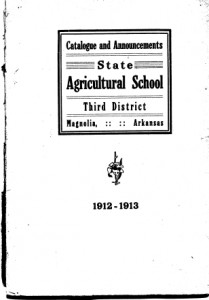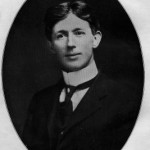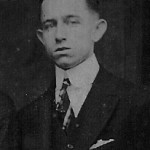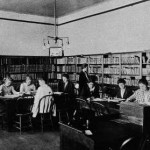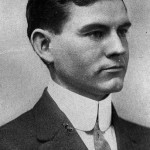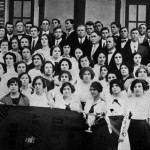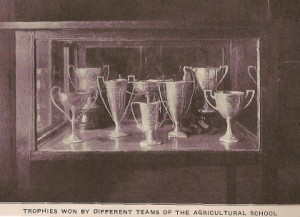(Excerpted from James F. Willis, Southern Arkansas University: The Mulerider School’s Centennial History, 1909-2009, pp. 55-54)
TDAS’s program for students was, as its second catalog explained, a four-year course of study “primarily technical” in content. It included only two majors—agriculture and domestic science (home economics). These required completion of a limited number of “literary courses” in English and the social and natural sciences. The liberal arts classes sometimes used content on issues and problems common to rural farms and homes. Vocal music was offered as an elective in order “to train boys and girls” for “the church and social life of their communities.” Elective enrollment in piano was small because the school had few pianos. A teacher of “expression” was employed, largely to prepare students for presentations and school plays. When TDAS’s curriculum had fully developed after five years, the 1915–16 catalog listed seventy-four courses. Of these, forty-eight were in agronomy, animal husbandry, horticulture, home science and home arts, and natural science often explicitly related to the vocational courses. The rest of the offerings were in English, history, mathematics, and music.
There was some teacher education because the legislature had mandated that agriculture be taught in the primary grades of public schools. During summers, TDAS usually had a normal course and certification testing that county education superintendents and education officials of the state conducted. Dr. [William S.] Johnson [principal, 1913-14] drew upon his experience at the University of Arkansas to introduce a normal course in TDAS’s regular session, including a “practice school” for student teaching, using his daughter and other campus children as pupils. Efforts to expand the institution’s teacher education offerings apparently ended when he resigned. One element, however, was continued in the domestic science and art department. Its curriculum had a senior course for those wishing “to teach Home Science and Art in the Rural High Schools of the State.” The course included “lesson plans and actual practice teaching.”
TDAS’s faculty assessed each entering student to determine an appropriate classification. Some students who had years of prior schooling thus began with a junior or even senior status. But most students started at the pre-freshman level and took a set of preparatory classes in English, history, civics, geography, arithmetic, and algebra. Such evaluation did not involve testing and took place in such a way, the 1916–17 catalog assured its rural readers, as “to remove the embarrassment often caused grown up boys and girls who have had little opportunity of securing an education.
Faculty tailored course requirements to meet student needs. This made it possible for the school’s first graduate, Woodford Smith, a local physician’s brother, to receive his diploma in 1912 after only one year of classes. The next year, Marvin Williams and Roy Turrentine graduated. Williams had been permitted to study for some courses on his own and then to pass challenge exams the instructors drew up.
Some students chose a course of study that led to a certificate rather than a diploma. No record has survived indicating how many certificates were awarded or who may have earned them. Catalogs, however, described requirements. A certificate candidate must have completed the agronomy, animal husbandry, or horticulture courses for men or the domestic science and art courses for women plus “such other work as the Classification Committee determined.” Earning a certificate apparently required few literary courses.
TDAS’s library was a low priority. Perhaps this was due to the school’s vocational emphasis and its uncertain appropriations. It had so few books, fewer than five hundred volumes after a decade of operation, that it occupied only a corner of an upstairs room in Old Main. James Peace, a Hendrix College graduate hired in 1914 to teach English, organized the first library, gathering books previously scattered in departments across the campus. He did so largely on his own initiative because he recognized the need. Most library materials were reference books, dictionaries, and U.S. Department of Agriculture publications. There were subscriptions to more than a score of popular magazines ranging from the Progressive Farmer and Good Housekeeping to the New Republic, Outlook, and Literary Digest. The faculty wanted students to become acquainted with current affairs and able to discuss public issues.
Debates and speeches were an essential element of education at TDAS but were largely regarded as extracurricular activities and conducted by two student organizations—the Garland Literary Society and the Yuma Literary Society. Literary societies were common in nineteenth-century American colleges and universities and remained so in the first decades of the twentieth century in Arkansas institutions. The University of Arkansas and several of the state’s colleges had Garland societies, named to honor August H. Garland, an Arkansan who served as attorney general in President Grover Cleveland’s cabinet. At some colleges, literary societies published student essays and poetry, but other societies substituted for fraternities. The Arkansas legislature had forbidden fraternities in the state’s schools. At TDAS, all students were placed in either the Garlands or the Yumas, named for the Indian tribe. The organizations did have parties on campus, but faculty sponsors closely supervised all events and made certain student members participated in the group’s educational activities. At their Friday and Saturday night meetings, Garlands and Yumas gained “practice in debate, oratory, declamation, essay writing and parliamentary practice.”
Faculty selected the best students from the societies to represent TDAS at regional and state contests. These events were the highlights of every year. Each April, high school delegations from across Southwest Arkansas gathered to seek academic and athletic honors at the Camden Cup Contest. Some fifty TDAS students and faculty boarded the Cotton Belt train at McNeil for Camden in 1914 and returned with twelve medals and two cups, including the sweepstakes award for the school scoring the most points.

